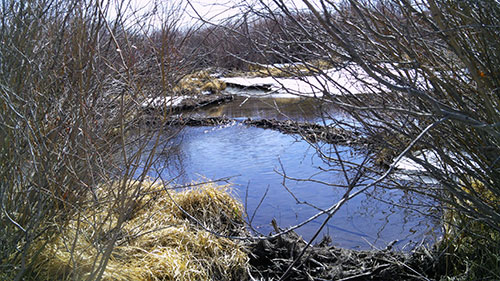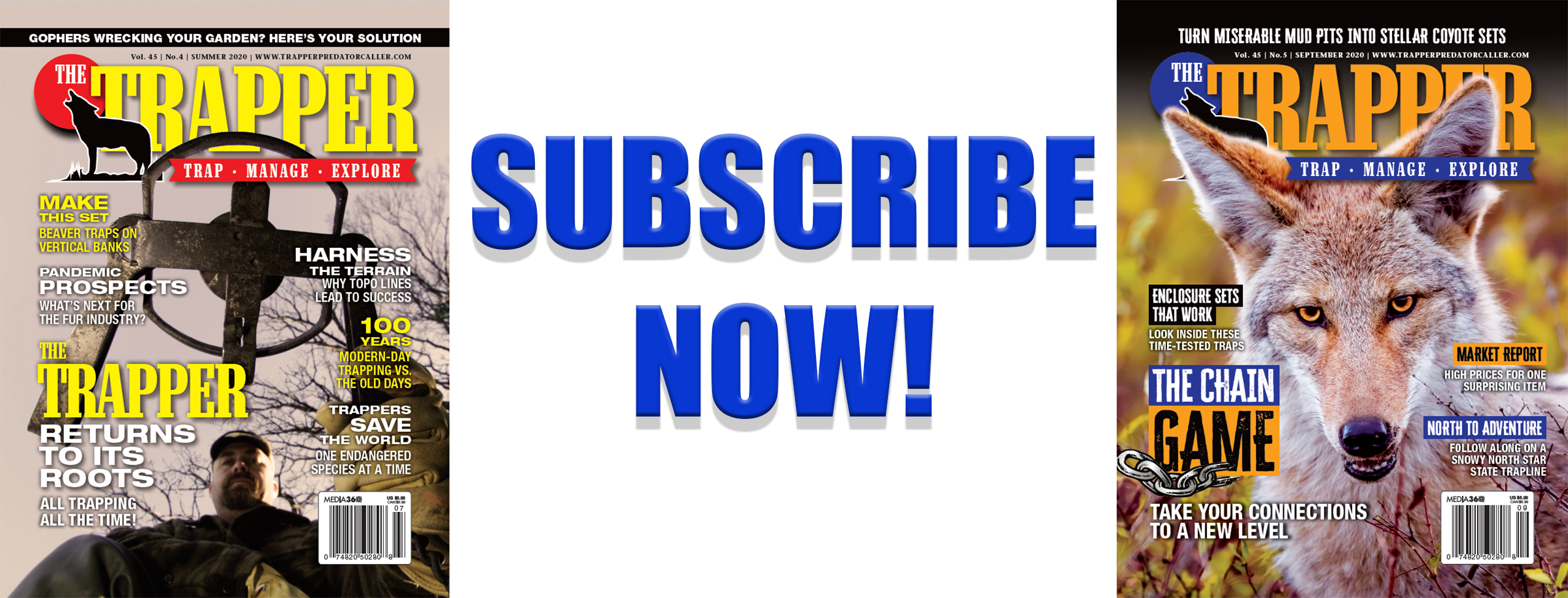The challenging conditions of pursuing flattails as winter turns to spring keep the author heading back out to the creeks, sloughs and ponds every year. Learn the sets that collect the castor despite the weather.
Text and photos by Dave Morelli
I really enjoy trapping beavers, but there isn’t much beaver trapping where I live these days. I still enjoy trapping a few of them every year, although with the prices so low I have to be satisfied with a high-quality, low-price fur.
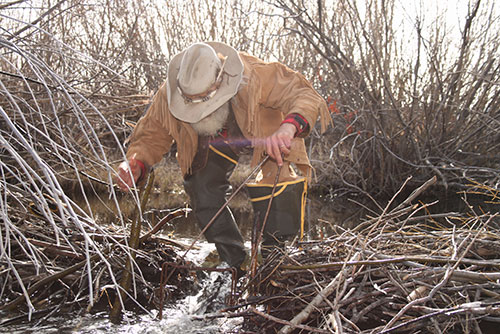
This was obviously a travel route as the local beavers were not fixing it. The author scored the first catch just a few days into the campaign. Photo credit Dave Morelli
The castor is really the prize with beavers, even though I rarely sell it because it is a main ingredient for some of the lures that I craft for the upcoming season. Still, I enjoy putting up some flattails every year. The bait is welcome for the spring bear hunt and the hide goes to some of the projects that I craft.
First of all, spring is a relative term in the high-altitude valleys that I live near. There have been years in the past when I was setting beaver traps in February wearing a T-shirt. Some years the weather was so warm that the snow melt-off caused flood-stage high water that was impossible to set in. During other years, the ice didn’t melt off of the water until late in April. Last year, I wasn’t able to get into the area I scouted until the second week of April, and even then there was some touchy ice over the creek that I had to walk across. OK, enough whining, here’s how it went last season.
I was trapping a section of creek that meandered through the sagebrush and was surrounded by 30 to 40 yards of willows. I had taken a trip into the spot a couple of weeks prior, but the roads still had some 4-foot snowdrifts that made it impossible to get close. Some warm weather cleared that up, although the creek still had ice over most of the ponds created by the beavers. I found the beaver lodge and it was also surrounded by ice that was just about thick enough to fall through. On the positive side, I did find some freshly chewed sticks scattered around all of the old slash. It looked like they were starting to move around and search for fresh food, since they had probably eaten most of their winter’s cache.

This beaver put its foot in the wrong spot, and the author’s double longspring trap did its job. Photo credit Dave Morelli
Something interesting that I did notice was the willows that were standing had chew marks on the bark about 5 feet above the ground. They were too small to support a beaver, or even a porcupine, so I assumed the critters were coming out on top of the deep snow and feeding on the tender willow tops. Maybe it had been a long, tough winter for them, too.
As time went on and more of the area’s ice melted away, I started to scout some set locations that looked like they would be productive. One was a beaver-size hole in one of the dams that caught my eye.
The spot was perfect for a 330, and me being an accommodating sort, I promptly put one in. There were fresh sticks below this spot so I figured the beavers were using the break in the dam, and it didn’t look like they were interested in plugging it up just yet. I love the areas where the 330 fits right in, the set is easy to make and there are no big mistakes that can be made to cause a miss. A few dead sticks through the springs and a tie wired off to a secure branch. I always tie them off because they can flop around and even find their way under some of the ice that hasn’t melted off. That’s kind of a bummer that is easy to avoid.
Some of the travelways between the ponds were canal-like, about 2 feet deep. Most of the ice was gone and a sunken 330 covered these really well. This is another set that is great for spring trapping because the weather around here will go from 35-degree days to 5 degrees at night, and if the water surface freezes a bit the trap is deep enough to stay working. Usually I carry a few of the channel set stands for 330s just for these sets.

Fresh willow is really attractive to beavers and the author will skin some of the bark off of a few for eye appeal at many sets. Photo credit Dave Morelli
On these underwater channel sets I always have a dive log a couple feet on either side of the trap to get a beaver to dive if it is swimming on the surface, and the ice will guarantee it is on the bottom when using the run. I like to set these a bit more than the trail over the dam because they are a little more foolproof with the changing temperatures.
I did set a few 330s on some trails that came up to an area with fresh chewing on the willows, but they were kind of a nuisance because the traps were frozen in on several of the mornings and had to be broken out and reset. There’s nothing like standing in sinking mud trying to break a frozen 330 out of the ice without getting it on your hand or arm. I don’t use the safeties they make for holding the jaws, but always have my conibear trap setter close by to get it off, just in case. Knock on willows I haven’t had to do that yet. As time went on some of the ponds opened up and I was able to get some foot traps set. I only had about three weeks to get some beavers out of there before the season ended.
Even though the snow and ice were melting, the water wasn’t rising and there were still a few shallow ponds that could be set with some front-foot-catch foothold traps. This set is designed to catch the beaver by the front foot so that the drowning wire will hold the front end of the beaver deep enough to be effective. I would rather have a rear-foot catch, but when there isn’t enough water you have to work with what you have. I set my #4 longspring trap about 4 to 5 inches deep and toss the anchor out into the deepest water I can get to. There were some ducks around, so setting it deeper helps to prevent catching them.
I stomped a shelf into the side of the water large enough for the trap to sit securely, and put some poke sticks in front of the traps so they will jab the beaver as it is swimming up to check out the lure. This will cause it to grab at the ground and step in the trap. The attractor is usually a mound of mud with some castor lure on it, and it is a good idea to set the trap off to the right or left a bit to accommodate the beaver’s anatomy.
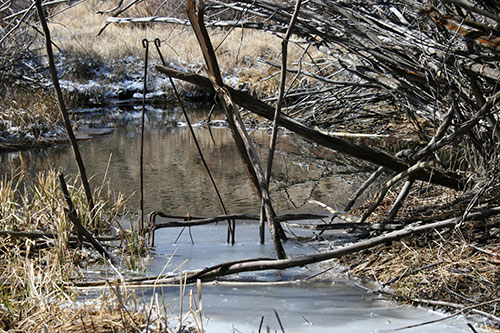
Spring mornings can be tough on the shallow-water sets with temperatures constantly fluctuating from freezing to thawing each day. Photo credit Dave Morelli
Unfortunately, changing temperatures can freeze up the stagnant shallow water and cause a miss, so just be aware of that when making the set.
As the water opened up more, there were several ponds near the lodge where the water was deep enough for a rear-foot catch — and I prefer this if I can set it. Really, the set is the same, just the trap shelf is deeper, maybe 10 to 12 inches. When the beaver comes to check out the scent mound, its body will sink until it feels the shelf and then it will try to push off of it to get up on the bank. BAM — ol’ flattail will be on the end of the wire in the morning.
A beaver’s rear foot is much larger and tougher than the front foot. There is less of a chance off a wring-out with the rear-foot catch, should it take awhile to get to the end of the wire. It also really helps to put some eye appeal around the mound. I often cut some fresh willows and skin them up a bit with the ax to show the inner white, they really like that.
For the most part, I set 330s for beavers these days because of how easy they are to set on trails and channels without using any lure. The castor mounds are interesting to the beavers in the spring because they are curious about the new critters coming into the area. Sometimes a lure can spook some beavers away from the set, so I don’t use it on the trail sets with 330s.
A week without a catch had me worried, even though I knew the beavers were moving around because there was scat in some of the deep pools. Freezing surface water was to blame for some of the problem, but the deep runs should have still produced. Then there was a connect on the 330 in the dam, and a couple days later one of the foot traps scored. It looked like the beavers were starting to move again and the channel sets were connecting.
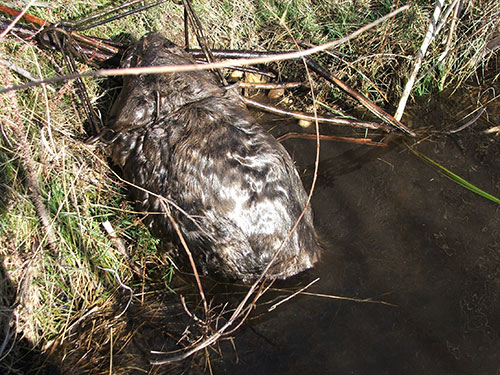
The deep-channel set is one of the author’s favorites in the spring since it is the most resistant to the changing temperatures. Photo credit Dave Morelli
Like I said at the start of this article, I don’t target beavers much anymore, but I really like to get out and catch a few every year. It is really for the enjoyment of the pursuit and for a few skins and some castor for making lures. Plus, taking a few of those flattails out in the spring keeps them out of the ranchers’ irrigation ditches.
Every year as the seasons change, the snow starts to melt and winter releases its frigid grip, I’ll be out there setting for a few spring beavers.
